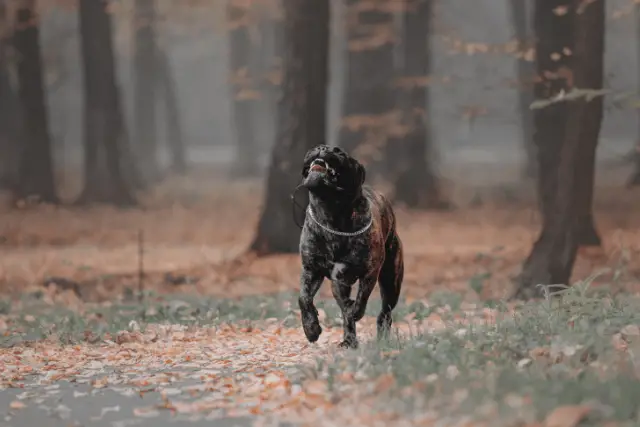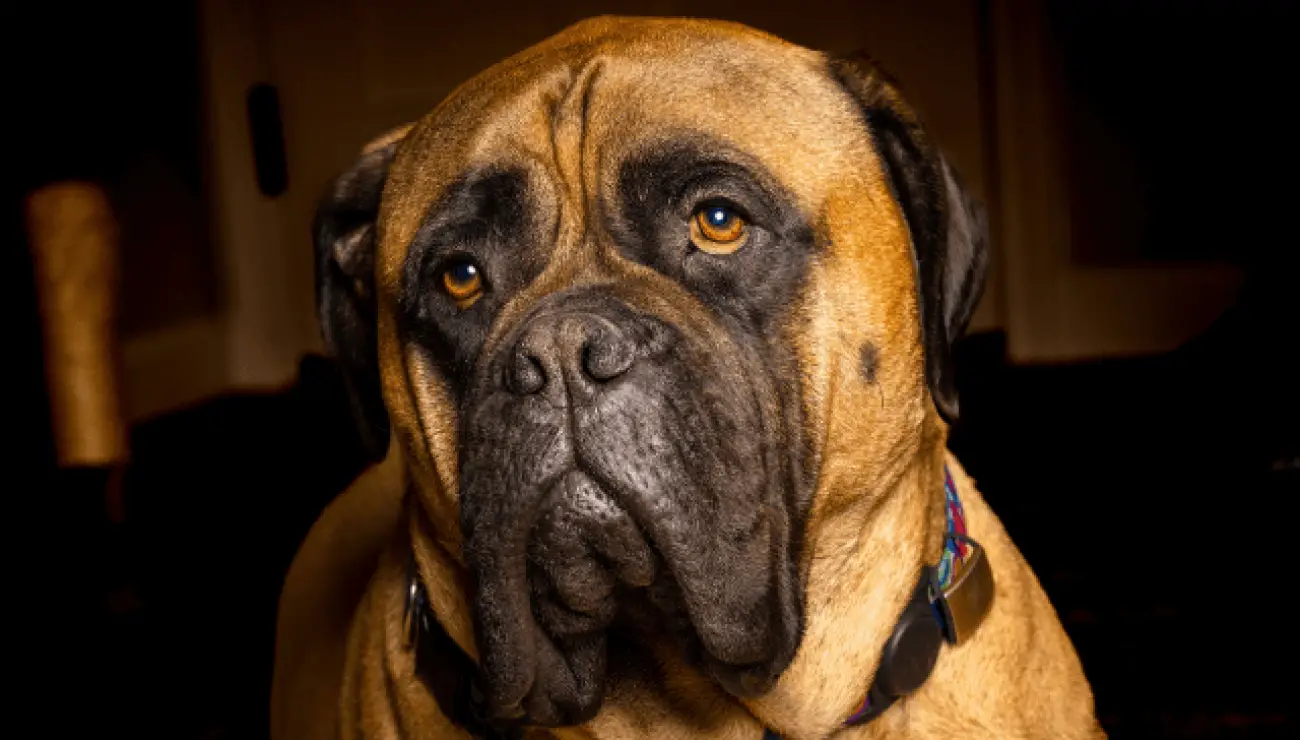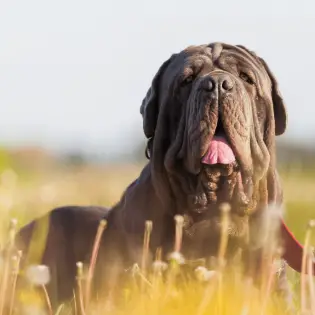Bullmastiff
Bullmastiff is a loyal, brave, and affectionate dog breed that can be a great family guardian. This dog is not afraid of anything, but he's got a soft spot for his family. In the wrong hands, this dog can be very dangerous, but also, in the right hands, they can be excellent family members who will be devoted to their family.
If you want to bring this dog into your family, we advise you to explore everything there is about them before you start searching for Bullmastiff breeders. This breed is not a good choice for the first-time owner because they can be strong-willed and because they need firm and experienced owners who will know to work with them.
When properly trained and socialized, they can be great family dogs that will get along well with everybody and especially kids. Although they are large dog breeds, they don’t require much daily exercise. These dogs will enjoy spending time with their family and participating in any activity. If there is a need, they will defend their home and family fiercely.
FUN FACT: The Bullmastiff’s nickname is “The Gamekeeper’s Night Dog.”

Height:
24–27 in (61–69 cm)

Weight:
90–130 lb (41–59 kg)

Origin:
Great Britain

Life Expectancy:
8-10 years
Dog Breed Characteristics
This dog has a large, broad, wrinkled head with dark eyes, v-shaped, naturally floppy ears, and a broad, short, square muzzle. They are powerfully built, symmetrical with great strength.
FUN FACT: Bullmastiff named Swagger is a mascot of the Cleveland Browns.

Grooming and care
Because of their wrinkled face, Bullmastiff is prone to develop skin issues, so the creases must be regularly cleaned. The coat comes in three colors: red, fawn, and brindle. Some Bullmastiffs will have small, white markings on their chest, which are acceptable according to the breed standard. The coat is short and dense, which protects the dog from rain, snow, and cold.
It is easy to maintain because these dogs don't shed a lot. Weekly brushing will be enough to keep Bullmastiff's coat clean and shiny. While Bullmastiffs don't shed a lot and are clean animals in that department, they certainly drool a lot. They drool after eating, drinking, and exercising, and when they are stressed… always, so it is recommended that you always have a towel around your Bullmastiff.
You should bathe these dogs only when needed. The rest is basic care – trim their nails when needed and weekly brush their teeth to secure healthy gums and fresh breath and to prevent gum diseases. To be sure that your dog will cooperate during all these things, you should start with them while your dog is young. If you make a positive experience for the dog full of praises and rewards, you can be sure that your dog will enjoy brushing, bathing, and everything else when he grows up.

FUN FACT: Bullmastiffs fart a lot. As they are short-faced dogs, they gulp air when they eat; that air needs to exit somewhere, and the result is gassiness. If you want to reduce this problem, try feeding your dog a homemade diet of real meat and vegetables
Exercise
These dogs will enjoy daily activity, although moderate exercise should be enough for dogs of this breed. If you let your dog off the leash, it should be only in fenced areas so that strangers and unfamiliar animals won't come into his territory if you want a dog who will accompany you during running, hiking, bike rides, etc. Bullmastiff is not best suited for you.
They can be a great walking companion. Be careful not to over-exercise your puppy because their joints and bones are still developing, and with too much exercise, you can hurt them, and they can have some serious problems later in life. They can adapt to apartment living if you provide them with their required daily activity.
This dog breed is also known as a great competitor in canine sports such as agility, obedience, and tracking.

FUN FACT: The Bullmastiffs are loud. They are not known to be barkers, but they snore, grunt, and snort loudly.
Socialization
Bullmastiffs are large, muscular, and tremendously strong, but extremely gentle and affectionate with family members. However, their friendly attitude will most likely change when there is a stranger near their people. These dogs tend to be suspicious of people outside the family. Early training and socialization are a must with this dog breed.
They can be strong-willed, and if you are consistent with the right training, you won't have problems because of that. If you are a new owner and don’t have experience with the correct way of training your dog, we advise you to search for professional help or even enroll your puppy in puppy class so he can become a well-rounded dog.

FUN FACT: Bullmastiffs used to have their tail docked to prevent them from being damaged, but when the Animal Health and Welfare Act came into effect in 2006, tail-docking was banned unless for medical reasons.
Bullmastiff - kids and other animals
This dog is a devoted, loving, and loyal companion. This dog is courageous and forms a very strong bond with their owners. The Bullmastiff can be territorial or even aggressive if there is a possibility that its family or property is in danger. With other people, this dog can get along if he feels they are welcome.
With other dogs, however, especially dogs of the same sex, he might not do so well. They need to be socialized and correctly trained, or they can start to show a more dominant side of their nature. As such, this large dog needs to have an experienced owner who can properly manage him. The Bullmastiff is an independent thinker, so train him firmly and consistently. This dog can be stubborn but obedient to his people's wishes.

FUN FACT: Bullmastiff named Butkus is a pet of Sylvester Stallone, and that dog was featured in the Rocky movie.
Health problems
These dogs are prone to heat exhaustion and heatstroke, so they don’t do well in hot and humid weather. They are made to live indoors with a big, soft bed and a lot of space for stretching.
They have an average life span of 8-10 years. They are generally healthy but are prone to certain conditions. Given their large size, Bullmastiffs suffer from several joint and structural problems, such as hip dysplasia and elbow dysplasia.
Bullmastiffs are also prone to pulmonic stenosis, which is a narrowing of the valve between the right ventricle of the heart and the vessel that carries blood to the lungs. Therefore, you should take your Bullmastiff to an annual heart exam.

Other diseases that everybody thinking about getting a Bullmastiff should be aware of are
- cancer (including lymphosarcoma, osteosarcoma, hemangiosarcoma, and mast cell tumor),
- hypothyroidism (caused by a deficiency of thyroid hormone that can be treated with medication),
- entropion (that causes the eyelid to roll inward and thus can injure the eyeball),
- bloat (the life-threatening condition where the stomach is distended with gas or air and then twists itself causing pain),
- progressive retinal atrophy,
- cystinuria (a genetic disorder that results in the formation of kidney or bladder stones),
- skin problems(they have sensitive skin that requires special attention. Their skin can be prone to rashes and irritations), etc.
If you want to be sure that your dog is healthy, there are a few recommended health tests you can perform: hip and elbow evaluation, ophthalmologist evaluation, cardiac exam, and thyroid evaluation.

FUN FACT: Bullmastiffs have a high pain threshold, so it can be difficult to determine if the dog is hurt.
FAQ
Bullmastiffs can be fantastic family dogs. They are calm and gentle towards their family members but quite suspicious of strangers. If you are looking for a large guard dog, the Bullmastiff might be a great choice.
Bullmastiffs are fairly large dogs that can reach a height of 24-27 inches and weigh as much as 130lb.
They can bite, just like any other dog breed. Bullmastiffs are naturally protective, so they might bite people that enter their territory.
Bullmastiffs can be fairly easy to train. They respond well to reward-based training methods and positive reinforcement. They are also independent, and training should be short and interesting.
Yes, Bullmastiffs are very independent, and they don’t require constant company to be happy. They are also great guards that are used to working alone.
This is entirely up to the owner’s preference. Females are generally milder and calmer than males, but individual dogs may have unique temperaments.
Bullmastiffs calm dawn at the age of two. They have a prolonged puppyhood, and by the time they are two, they become a lot calmer. The only condition is that they have plenty of exercises.
Bullmastiff breeders
When buying a Bullmastiff, go to a reputable breeder to get a healthy dog with all the characteristics one Bullmastiff should have. Never acquire a dog from a pet store or a puppy mill breeder. They cannot guarantee that your puppy had healthy ancestors. Reputable breeders, however, perform various health tests to ensure that their breeding dogs don’t pass on a predisposition to genetic diseases.
Ask the breeder to show you all the health clearances dogs should have. Ask for references so you can contact other buyers and see whether they are happy with their puppy. It is important to know that some health problems do not appear until a dog reaches full maturity, so health clearances for those diseases can’t be issued. Therefore, you should make sure that the breeder does not breed dogs until they are two or three years old.

To be completely sure that you talk to official and responsible Bullmastiff breeders, we advise you to search them only on the World Dog Finder website or at the cynological association of your country. You always need to be careful when buying a puppy, but this way, you can be sure that the breeder you are talking to is registered.
Bullmastiffs are big and strong dogs that can be great family members and that will protect their family if there is a need for it. With the right training and socialization, they will develop into well-rounded dogs that can be trusted, and that will get along with everybody.
World Dog Finder team

Updated at31.08.2023.
Breed History
The Bullmastiff is a large and powerful dog breed developed during the mid-19th century, probably around 1860, by British gamekeepers who needed a fearless and fast dog to track down poachers and protect their country estates. These dogs are a result of crossing a Mastiff with a Bulldog. The ideal Bullmastiff appeared to be 60 percent Mastiff and 40 percent Bulldog.
In the early 20th century, Bullmastiff began to be bred as a distinct type of breed rather than as a crossbreed. Today, Bullmastiffs are more likely to be loyal family pets but very alert and always ready to protect their humans and their property.


















Share